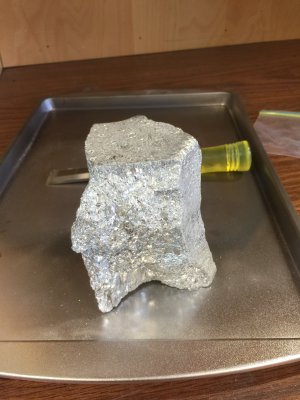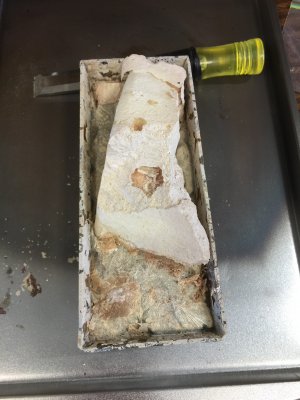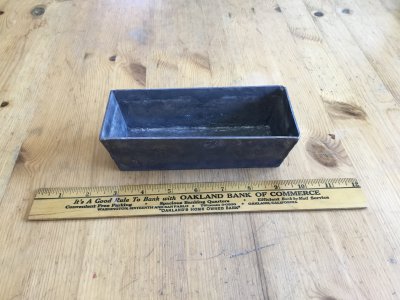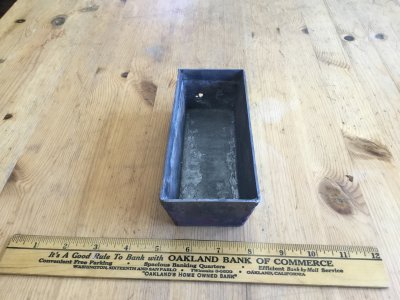As folks on this list may know, I am building up a small collection of 1” x 2” x 6” bars of elements. Safe elements—no arsenic. (But yes, lead) I have a dozen now on the mantle. Each is wonderful in some special way.
I am now working on Antimony. Melts at a reasonable temperature—under 1200F. So, with a small hobby kiln should be easy. Not.
First picture shows the nice shiny lump I bought. Sort of crystalline (and heavy) like Bismuth.
First problem is that when hot (like near to melting) it is reactive with air. Oxidizes? Rusts? Burns? Whatever—I am not a chemist. Forms a brown crumbly material. The second picture shows the outside oxide layer of the original lump, the inside had, indeed, melted down. I learned that if I keep the kiln closed the whole time there is not too much oxide formed. Maybe I can put some carbon or such into the kiln to suck up the oxygen before the antimony does?
I do my melting in a small steel “bread pan” I welded up. See third picture. Has work well for a half dozen elements so far. I coat the inside with the release agent LB771 Loctite Nickel Anti-Sieze.
Second problem (so far) is that it seems like hot antimony corodes steel. Even though I have the LB771 coating. Ate a hold right through the steel. See fourth picture. Something about the liquid Antimony embrittlement or dissolving the steel? Anyway, I plan to weld up the hole. Smooth out the side. And try again with thicker LB771 coating.
Have not yet started to try to machine the Antinomy—but, given how the crystals look, I fear this is going to be my terrible Bismuth experience all over again. Tiny tiny bismuth powder sprayed everywhere—requiring a hood to be draped over the mill, breathing mask, and an hour of careful clean-up. Also, sacrificial aluminum rails to prevent edge shattering. We will see.
-Bill




I am now working on Antimony. Melts at a reasonable temperature—under 1200F. So, with a small hobby kiln should be easy. Not.
First picture shows the nice shiny lump I bought. Sort of crystalline (and heavy) like Bismuth.
First problem is that when hot (like near to melting) it is reactive with air. Oxidizes? Rusts? Burns? Whatever—I am not a chemist. Forms a brown crumbly material. The second picture shows the outside oxide layer of the original lump, the inside had, indeed, melted down. I learned that if I keep the kiln closed the whole time there is not too much oxide formed. Maybe I can put some carbon or such into the kiln to suck up the oxygen before the antimony does?
I do my melting in a small steel “bread pan” I welded up. See third picture. Has work well for a half dozen elements so far. I coat the inside with the release agent LB771 Loctite Nickel Anti-Sieze.
Second problem (so far) is that it seems like hot antimony corodes steel. Even though I have the LB771 coating. Ate a hold right through the steel. See fourth picture. Something about the liquid Antimony embrittlement or dissolving the steel? Anyway, I plan to weld up the hole. Smooth out the side. And try again with thicker LB771 coating.
Have not yet started to try to machine the Antinomy—but, given how the crystals look, I fear this is going to be my terrible Bismuth experience all over again. Tiny tiny bismuth powder sprayed everywhere—requiring a hood to be draped over the mill, breathing mask, and an hour of careful clean-up. Also, sacrificial aluminum rails to prevent edge shattering. We will see.
-Bill





